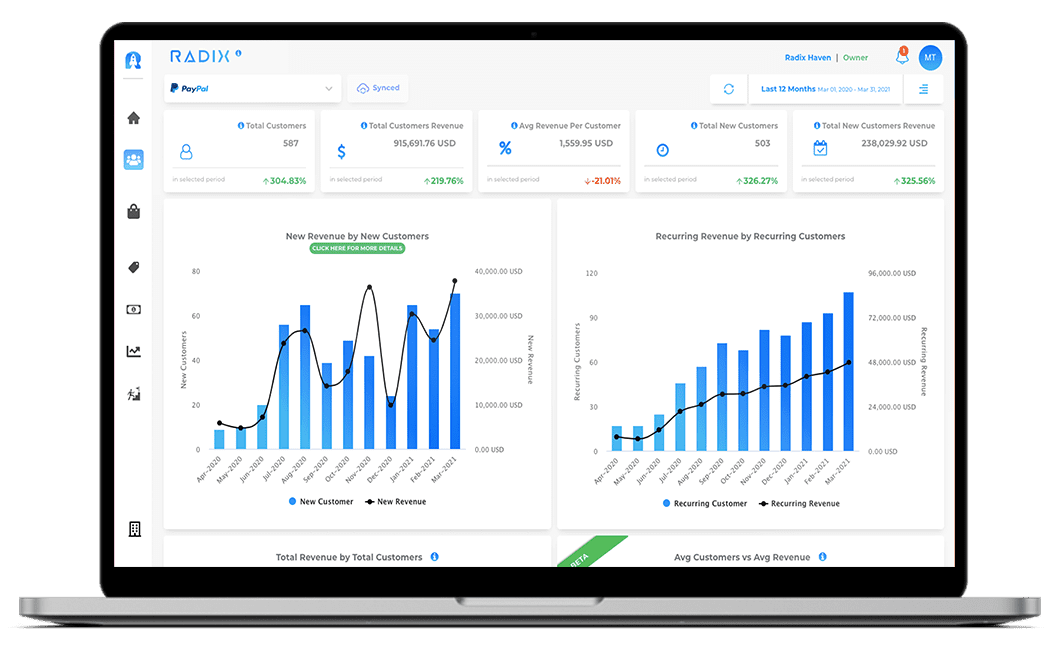How can you grow your B2B business without attracting new customers? Keep your existing customers. What is the challenge? To make sure you’re making the right decisions for your company, follow a data-driven strategy for customer retention.
Learn how to calculate MRR here.
How to measure customer retention:
- Count the total number of customers you had after some time (month, quarter, or year).
- Subtract the total number of customers from the number of new customers you gained.
- Divide this result by the number of customers you had at the start of the period.
- If you had 100 customers in the beginning, 90 at the end, and 5 new customers, your retention rate would be 85%.
Formula:
- Customer Retention Rate = (Customers at the Period’s End) – (New Customers Acquired) / Customers at the Period’s Beginning
Retention Rate is sometimes mistaken with the Churn Rate. These two metrics, however, are fundamentally opposed.
The ratio of customers who return to do business with your company is the retention rate. This is distinct from churn rate, which relates to the amount of customers you’ve lost over time. A business with a high churn rate will have a lower retention rate by default.
Understanding the distinction between these two criteria will save you from making a costly error later.
Understanding all customer retention metrics may help you have a productive month, quarter, and year ahead.
What is the importance of customer retention metrics?
The more customers you keep, the more recurring income you can make or upsells and cross-sells you can obtain in the future. Furthermore, a customer that sticks with you is satisfied with your products and services, which increases the possibility that they will refer new customers.
Customer retention data may help marketing, sales, customer service, and even product management teams. This data assists each team in fine-tuning their contribution to the customer journey and creating more engaging experiences for your user base.
1) Customer Churn:
It refers to the rate at which customers stop doing business with you. A churned customer is a customer your company did not retain, regardless of whether the customer terminated or opted out of renewing a subscription.
A high churn rate often indicates that your product or service is failing to satisfy the expectations or goals of your customers.
Churn Rate Formula
- Annual Churn Rate = (Number of Customers at Start of Year – Number of Customers at the end of Year) / Number of Customers at Start of Year
*periods depend on how you want to measure it.
2) Revenue Churn Rate:
Your revenue churn rate is the proportion of revenue lost from current customers over a specific time period. For example, revenue churn might occur as a result of an order cancellation, a plan downgrade, or the termination of a business relationship. Revenue churn rate is an important metric of customer satisfaction, especially for SaaS (Software as a Service) corporations.
If revenue churn occurs, your customer may be on the point of abandoning — and your operations or services department must move swiftly to prevent this from happening.
Revenue Churn Rate Formula
- Monthly Revenue Churn Rate = [(MRR at Start of Month – MRR at End of Month) – MRR in Upgrades during Month] / MRR at Start of Month
3) Existing Customer Revenue Growth Rate:
A rising rate indicates that your marketing, sales, and account teams are doing an excellent job of persuading customers to spend more. It also suggests that your customers quickly recognize the importance of your involvement.
Customer Revenue Growth Rate Formula
- Monthly Revenue Growth Rate = (MRR at the End of Month – MRR at the Start of Month) / MRR at the Start of Month.
4) Repeat Purchase Ratio (RPR):
(RPR) is the percentage of customers who have returned to your business to purchase again. This excellent predictor of customer loyalty, and it is frequently used by marketing and sales teams to evaluate the effectiveness and impact of the company’s customer retention strategy.
Repeat Purchase Ratio Formula
- Repeat Purchase Ratio = Number of Returning Customers / Number of Total Customers
5) Net Promoter Score (NPS):
The Net Promoter Score quantifies overall satisfaction and brand loyalty. Once you’ve determined your total Net Promoter Score, you’ll know if your customers are satisfied and eager to recommend your product or service to others.
Furthermore, if your Net Promoter Score is compared to your revenue growth rate and customer churn rate, you may be able to estimate prospective growth through customer retention and referrals.
A low or average score, on the other hand, allows you to remedy a dissatisfaction issue before it’s too late.
This score is calculated by asking a single question to your customer: “How likely are you to recommend our service to a friend or colleague?”
Net Promoter Score Formula
- Net Promoter Score = % of Promoters – % of Detractors
6) Customer Lifetime Value (CLV):
Customer lifetime value (CLV) quantifies the amount of money generated by a single customer. This parameter should be tracked regularly whether you offer individual products or services or software that is invoiced annually (or monthly).
CLV should ideally grow or remain constant since falling CLV indicates that you’re either gaining low-value customers or losing customers quicker than in the past.
To begin, calculate the average revenue you may expect from a customer throughout a period. Divide your gross yearly (monthly) revenue by the number of unique customers in that year (month) to arrive at this figure.
Then, in terms of years (months, etc.), you’ll want to figure out how long a customer remains with your company.
Then, multiply the average revenue per customer by the customer’s average lifespan to calculate the customer lifetime value
Try Radix to do this and more.






